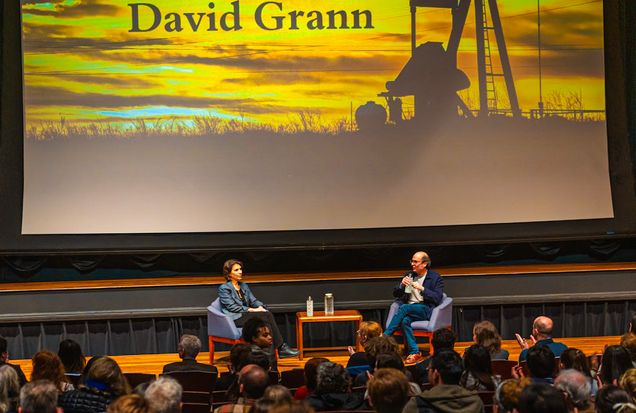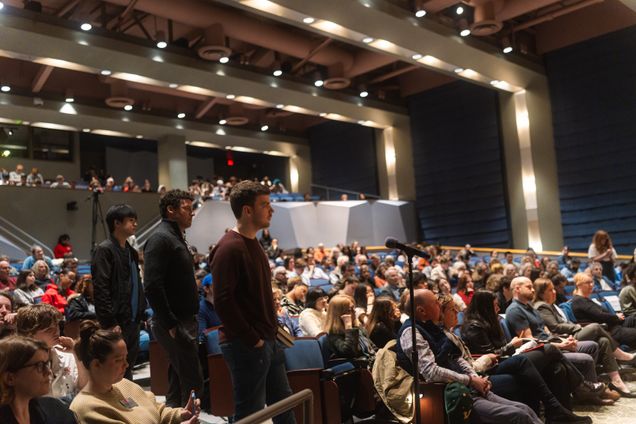An Evening with David Grann
David Grann joins Professor Debbie Danielpour for a conversation about his life and work
Write-up by Margot Rashba, PhD Candidate in History

On February 28th, Boston University’s Conversations in the Arts & Ideas hosted David Grann, the widely acclaimed author of several works of narrative non-fiction including The Killers of the Flower Moon (2021) and his most recent publication, The Wager (2023). Grann and Professor Debbie Danielpour of BU’s College of Communication spoke on his route to non-fiction, the research process, and the value of storytelling.

Before the evening’s formal conversation, David Grann’s son, Zach Grann, a sophomore at Berklee School College of Music performed a musical introduction. A piano piece inspired by his father’s book, The Wager, echoed the plot of the book, which centers on the shipwreck and subsequent mutiny of the HMS Wager in 1741. Carrie Preston, a BU Professor of English, and Brian McGrory, the former editor of the Boston Globe and current director of the College of Journalism at BU, gave additional introductions. Emphasizing Grann’s “mastery of the craft” and “relentless reporting,” McGrory highlighted Grann as an authoritative voice in a world of “unreliable narrators.”
The conversation between Professor Danielpour and Grann began with a foray into his path as a writer. Reflecting on how he would always tell stories in chronological order and often struggled to make deadlines as a journalist, Grann stated that one of the biggest career revelations for him was applying creative writing techniques to non-fiction. Marrying the technique and structure of creative writing to narrative non-fiction propels the story forward and gives life to historical actors that may be obscured within the archive.

Much of the evening centered on the writing and research of The Killers of the Flower Moon, partially due to the upcoming 2024 Academy Awards where the film adaptation of Grann’s book received a whopping 10 nominations, including Best Picture. The Killers of the Flower Moon tells the story of a series of murders perpetrated by white people against the Osage Nation in the 1920s due to the rich oil reserves on their land. Grann tracks the investigation of the crimes against the Osage people by focusing on Mollie Burkhart, a member of one of the targeted families, Tom White, an employee of the newly formed FBI who was part of the team on the Osage case, and finally in his own voice as a reporter, uncovering a story that exposed a vast conspiracy in Oklahoma to rob the Osage of their wealth.
Grann, who served as an advisor on the film, noted the crucial differences between film and non-fiction writing. A film can gesture at the internal lives and emotions of historical actors that the archive cannot. Grann was unable to make Mollie the center of the entirety of the book because of the limitations of his sources, but a film can take a more suggestive stance and fill in these gaps. In this way film and books present completely different approaches that each have their unique benefits. For Grann, the most important part of the film was a shared commitment to and involvement of the Osage in their own story. Many individuals that Grann worked with acted in the film, such as in tribal council scenes.

While Grann has no personal or familial connections to the Osage, he was struck by the “great privileges and great challenges” of writing a story he is personally removed from. Grann readily admits that there are disadvantages stemming from initial lack of knowledge but adds that the advantage of relative ignorance lies in seeing these histories with new eyes. While working with the Osage he strove to be patient, cultivating relationships with community elders and gaining the trust of descendants. Grann anchored Killers of the Flower Moon in Osage history and culture as he worked with the community to recount a traumatic moment in their history. Taking this process a step further, Grann even spent a night on the prairie as a way of immersing himself within the environment his historical subjects experienced. While these moments did not appear in the book per se, this full investment in the community is an essential part of Grann’s writing process.
Grann’s next project will explore truth amidst the challenges of constant misinformation. Grann observed that we all have to be researchers, evaluating sources, cross-referencing, and staying honest about what sources tell us, even when it is inconvenient. Always searching for themes that are relevant to today, Grann has the masterful ability to tie episodic moments in history to contemporary concerns. Any journalist knows the challenges and benefits to telling other people’s stories, yet Grann skillfully demonstrates that staying transparent, humble, and listening to others creates the most compelling narratives.